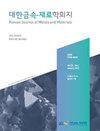增材制造A356.2铝合金残余应力的x射线衍射分析
IF 1.1
4区 材料科学
Q4 MATERIALS SCIENCE, MULTIDISCIPLINARY
引用次数: 0
摘要
金属基结构材料的物理性能,如硬度、强度和韧性,直接或间接受到给定零件内部或表面残余应力的影响。增材制造过程中重复的快速加热和冷却会导致材料的热梯度和膨胀和收缩,从而导致残余应力。众所周知,添加剂制造的产品表面存在拉伸残余应力,应将其保持在最低限度,因为它们会影响机械性能并导致产品变形和产品失效。因此,重要的是评估产品制造后的残余应力,并将其控制在所需的条件下。由于重复测量、产品尺寸和成本问题的困难,使用通常用于增材制造产品残余应力评估的破坏性方法存在局限性。因此,有必要应用无损评估方法并验证该方法的有效性。在本研究中,A356.2铝合金粉末采用粉末床熔融工艺进行增材制造,并测量了该工艺过程中产生的表面残余应力。采用X射线衍射(XRD)方法对表面残余应力进行了观察。XRD测量后,使用Williamson-Hall图、sin2ψ和cosα方法进行分析。讨论了通过LPBF工艺制造的样品的残余应力测量结果以及每种方法的特点和局限性。本文章由计算机程序翻译,如有差异,请以英文原文为准。
Residual Stress Analysis of Additive Manufactured A356.2 Aluminum Alloys using X-Ray Diffraction Methods
The physical properties of metal-based structural materials, such as hardness, strength and toughness, are directly or indirectly affected by residual stress inside or on the surface of the given part. Repeated rapid heating and cooling during the additive manufacturing process causes thermal gradients and expansion and contraction in the material, which causes residual stress. Tensile residual stresses are known to exist on the surface of additive manufactured products and should be kept to a minimum as they affect the mechanical properties and lead to product deformation and product failure. Therefore, it is important to evaluate the residual stress after making the product and to control it under the desired conditions. There are limitations to using the destructive method commonly used for residual stress evaluation with additive manufacturing products, due to difficulties in repeated measurements, product size, and cost issues. Therefore, it is necessary to apply a non-destructive evaluation method and verify the validity of the method. In this study, A356.2 aluminum alloy powders were used for additive manufacturing using the powder bed fusion process, and the surface residual stress generated during the process was measured. X-ray diffraction (XRD) methods were used to observe the surface residual stress. After XRD measurement, analyses were performed using the Williamson-Hall plot, sin2ψ, and cosα methods. The residual stress measurement results of samples manufactured through the LPBF process and the characteristics and limitations of each method were discussed.
求助全文
通过发布文献求助,成功后即可免费获取论文全文。
去求助
来源期刊

Korean Journal of Metals and Materials
MATERIALS SCIENCE, MULTIDISCIPLINARY-METALLURGY & METALLURGICAL ENGINEERING
CiteScore
1.80
自引率
58.30%
发文量
100
审稿时长
4-8 weeks
期刊介绍:
The Korean Journal of Metals and Materials is a representative Korean-language journal of the Korean Institute of Metals and Materials (KIM); it publishes domestic and foreign academic papers related to metals and materials, in abroad range of fields from metals and materials to nano-materials, biomaterials, functional materials, energy materials, and new materials, and its official ISO designation is Korean J. Met. Mater.
 求助内容:
求助内容: 应助结果提醒方式:
应助结果提醒方式:


